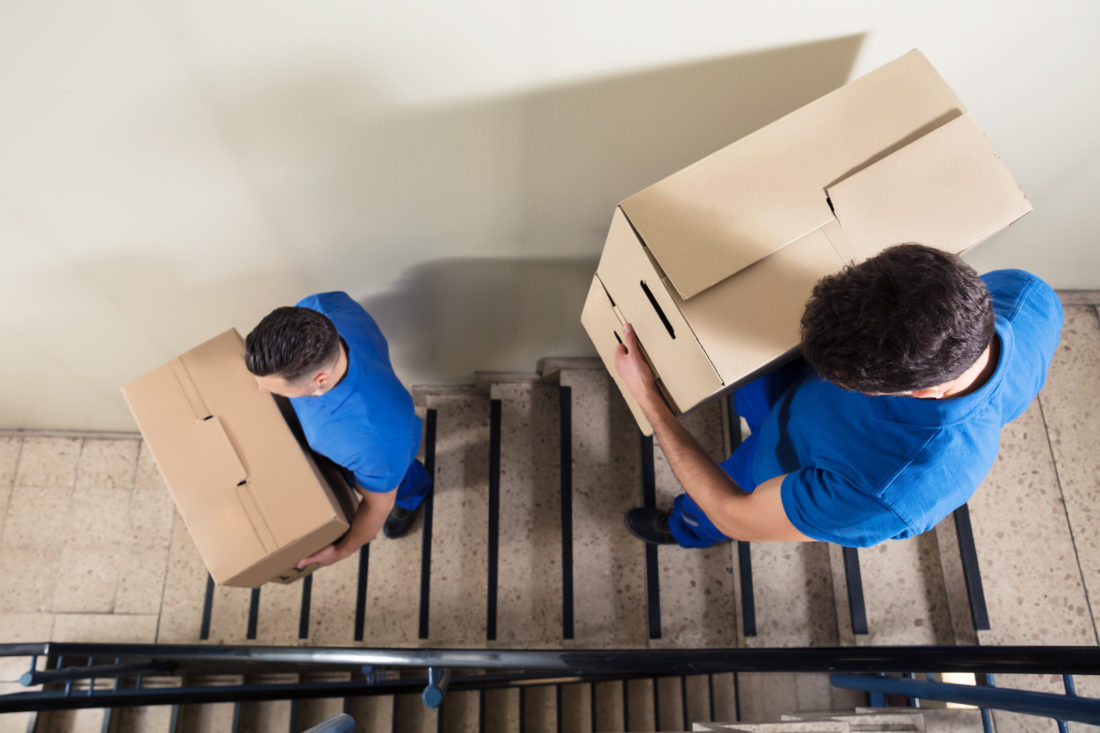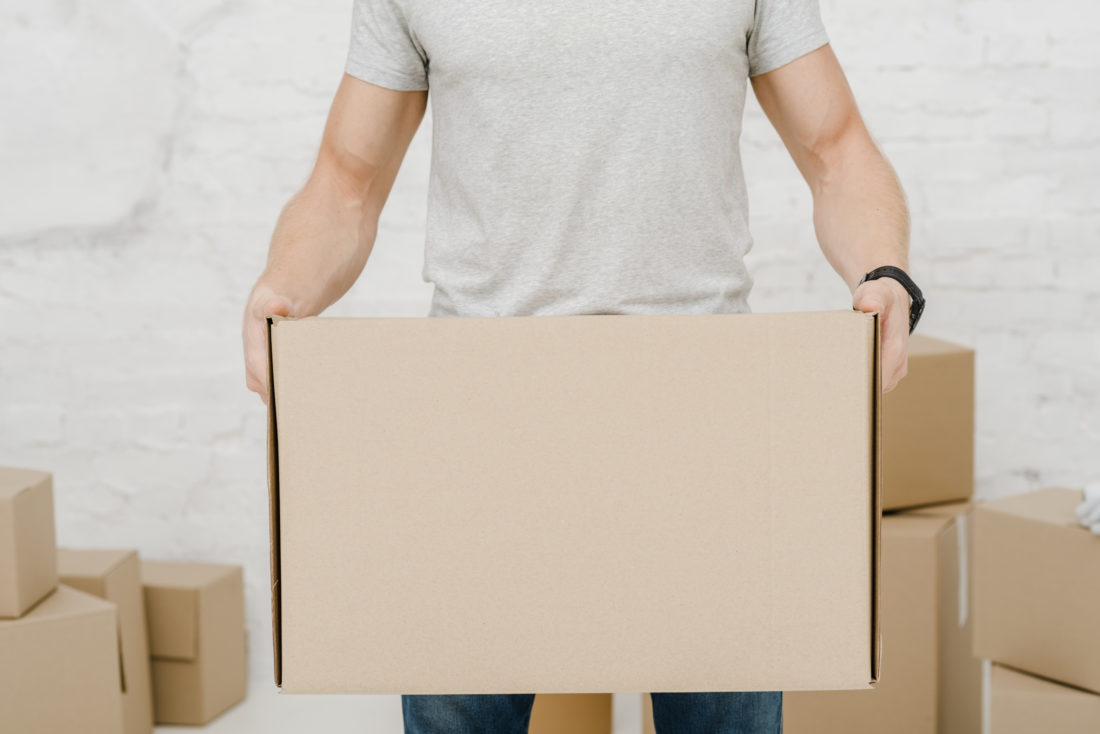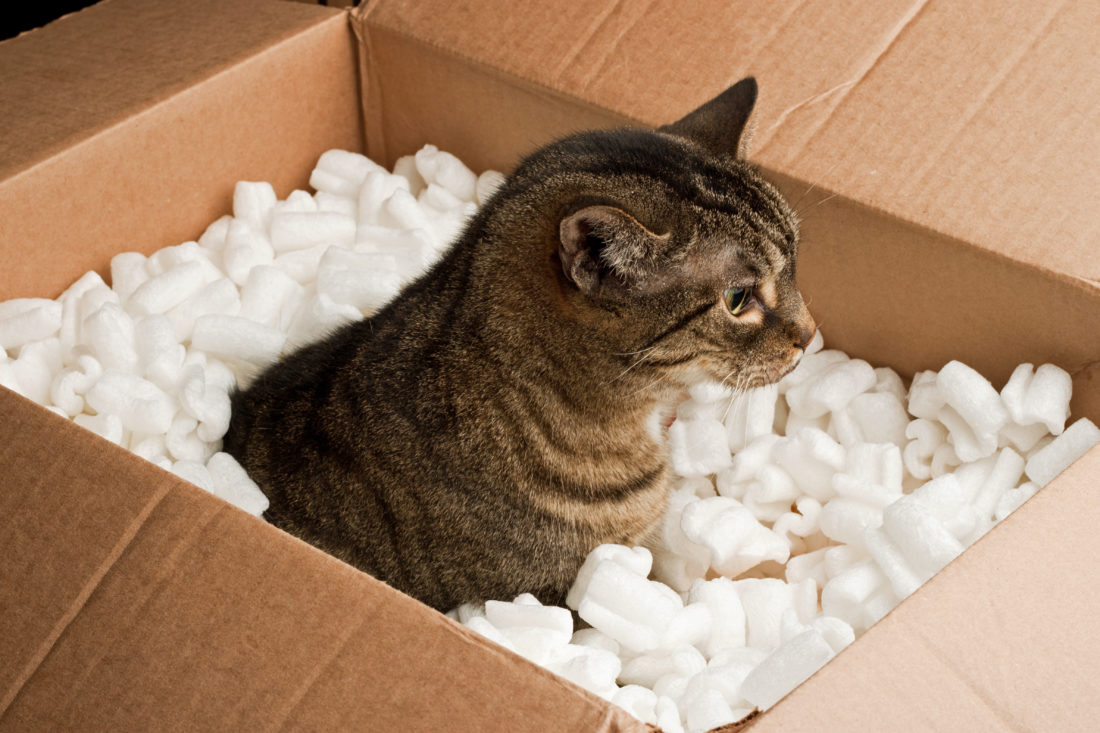

If you’re about to jumpstart da new life in an entirely different location, you will unquestionably need a helping hand – at least in the form of useful tips and tricks. Reading this ultimate moving guide will put all the significant aspects of relocation into perspective. Get ready to move with this useful advice.

Firstly, you will have to grasp the psychology of relocating and find out about potential issues you might face throughout the process. Then, consider your options – starting with resolving whether you’ll have a DIY move or contact professional long-distance movers. If you choose to go with the pros, it’s important to learn how to avoid scammers. And if you’re about to handle the whole move individually, we have a few tricks up our sleeves that will ease the packing process, decluttering and donating items included. We will also feature some after-move suggestions and guidelines in this article.
Learning how to deal with moving stress is paramount. Let’s face it – even when you’re fully prepared for the process, and even if you have hired the most competent cross-country movers, moving is still challenging. And like all significant changes, they affect our usual patterns, ways, and routines. That’s why your prime goal should be to retain a healthy sleeping schedule. Get some rest before the day of the move. You will need every extra atom of energy.
Another closely related tip is to stay hydrated and eat well. This works for every single situation, but it’s easier to let it slip from your mind than you might think. Lastly, it would be excellent to ease the tension by exercising or meditating.
Other things that can help you relieve some moving stress include:
Picking the best time of the year to move, when moves are more affordable, and the whole market is less hectic
Starting to prepare timely and planning every step carefully,
Writing down all tasks, chores, lists, and calculations, and keeping them visible,
Doing a lot of research, from looking at quotes and reviews to find the best long-distance movers to exploring meticulously how safe your neighborhood is,
Focus on the good things that await and find a job before relocating to minimize the stress accompanying all major changes.
Everyone gets intimidated by big changes. And moves are among the most dramatic changes in our lives. The fear of moving is one of the most common problems you can bump into. Luckily, overcoming it isn’t that hard. Here are a few steps you can follow to make things easier:
Anxiety about moving out is also a widespread issue. Although experiencing it seems scary, there are ways to combat it. But first, you must learn to spot the warnings signs:
If you start to experience these symptoms, there are simple methods to keep them under control. Leading a healthy lifestyle will surely help. Eating clean, cutting down on alcohol, caffeine, and tobacco will make you feel more relaxed. Being active and taking walks will also normalize your heart rate and help your sleeping pattern. Lastly, you can conquer the fear of the unknown by exploring and visiting the city you have chosen to call home. And talk to your friends and family throughout the whole process for extra support.
Relocation depression is another familiar struggle for many. Having a clean start is always a good idea. However, leaving behind the neighborhood you have gotten used to and the people you have shared your days with is tough. Handling these changes is essential, and here’s how to do it:
Also, some proven patterns will help you with any issue when it comes to your mental health. Much like anxiety, depression can be reduced and overcome by maintaining healthy habits, eating well, and having a normal sleeping schedule. If none of this works, don’t hesitate to contact a professional therapist.

Everyone who’s been thinking about relocating has their head filled with questions. First, there is a list of reasons to move that you must go over. Then, there comes the time to ask yourself – where should I move? And once all of these priorities have been aligned, you must consider other crucial aspects of your relocation. From the budget at your disposal to the amount of time you have on your hands – each segment is significant when determining whether you should pick a DIY move or hire professional cross-country movers.
Both alternatives have their advantages and disadvantages. However, getting in touch with an expert team and acquiring their services is far more comfortable, simple, and time-saving. It is your best choice to rely on the skilled squad if you need to move to another state alone or with family. Finally, it will reduce the risks of losses, breakage, or any damage during transport.
Each company has some universal regulations and guidelines they follow when giving an estimate, fulfilling their obligations toward a customer, and forming their price range. In general, this is the basic info you need to know:
The range of services you can acquire also include partial or full packing service, renting a storage unit, obtaining moving insurance, and asking for auto transport (vehicle shipping).

Unfortunately, moving scams aren’t that rare. Still, there is a lucky circumstance – it is quite easy to spot them. All you need to do is research and keep your eyes wide open for the red flags:
Various name changes and frequent alterations of this kind,
Not providing a phone number or any other relevant information on the website,
Suspiciously low (or high) estimates,
Providing an estimate based on cubic feet,
Declining to provide a template of an agreement.
What’s more, you can effortlessly run a background check on every local or long-distance moving company through the FMCSA database. All you have to do is to insert their USDOT number into the search bar. This brings us to another thing that should alarm you – if there is no USDOT number displayed on the company’s site, you should avoid making a common moving mistake and hiring that team.

Getting ready to move and organizing everything implies multiple assignments you have to fulfill. Some of the most important tasks that await include:
Creating a relocation binder
Making a checklist and a calendar to stick to,
Planning your budget step-by-step,
Gathering packing materials,
Researching cross-country moving services,
Sorting and decluttering your household,
Learning some packing tips,
Creating a home inventory with photos
Cleaning the old home before you move out and getting prepared for the big day.
When starting from scratch in a new location, you will unquestionably need an extensive moving to a new state checklist. Here’s what it should encompass in a nutshell:
Additionally, when checking out how the state’s regulations work, see when you will have to renew your driver’s license or re-register the car. Also, be sure to arrange a transfer for utilities and change the address at the post office. Since these are the things you can easily forget to do when you move, highlight them.
Planning a budget entails creating a checklist of moving expenses. This list should incorporate:
On the other hand, when choosing to collaborate with professional movers, these are the main factors that will impact the price:
Also, you will have to take into account some extra fees that might pop up, like an extra charge for storage service – so it is best to save up a bit more before the move.
Getting the fitting boxes, materials, and equipment is crucial. You will undoubtedly need to get some of these basics:
These are the unavoidable supplies you should get. Based on your specific needs, you might want to compose a more extensive list.
If you choose to get professional help with the relocation, you must look into the service providers timely. According to experts, the right time to decide and start the search for reputable long-distance movers is two months before the planned day of the move. Shortlist the companies that seem to suit your necessities and finances. Check out their reviews and testimonials, get a free quote, and be sure to ask all relevant questions.

There are things you must do before you start to pack. Sorting and purging your items is at the top of the list of priorities. Firstly, once you declutter your home, everything will seem tidier and easier to manage. Also, the packing process itself will take less time. And finally – this way, you will save money to move out of state.
Here’s how to reduce the clutter in your household before switching to a new residence:
Give yourself enough time and create a strategy,
Pack a box with relocation essentials and avoid tossing anything that you’ll undoubtedly use,
Leave the items with sentimental value for last,
Check expiration dates and dispose of all products and food that can no longer be used (or is about to expire),
Get rid of everything that’s outdated, broken, damaged, or no longer suitable for your home.
Deciding what to keep when you move is somewhat difficult. Saying goodbye to some priorly used possessions (that now most likely just collect dust) isn’t an easy job for many. However, there is a list of things you must keep, pack carefully, and keep secure:
Before you determine your precise needs and aspirations, double-check your future home, take a second glance, a detailed walkthrough, and measure each room carefully. That way, you will be in the clear regarding what to pack.
When decluttering, go room by room and use three boxes – one of them for the belongings you’ll keep, another for the items you can sell or donate, and the third one for the stuff you will throw away or recycle.
You can donate old appliances that are in good condition, and you can do the same with furniture, clothes that no longer fit, old toys, books, and other unwanted items. Basically, any item you no longer want to use that’s still in decent shape can be donated. Look for charities in your area and contact them to see whether you can drop off some of the stuff. If you want to save some time, schedule a pick-up service.
But before you do, make sure that each item is clean and boxed up properly. Salvation Army is one of the primary organizations to give your old or unused belongings.
Organizing a successful garage sale takes only some planning. Pick the best time and advertise the event so you have the most visitors and potential buyers. Friday afternoons and weekends are usually the ideal times for this sort of thing if the weather is right.
Purchase or get for free some cardboard boxes and buy or make price tags. These aren’t the only supplies you will have to collect. Think about how you will display your belongings and get some tables, chairs, or benches. Organize your belongings according to their category so that the people interested in buying them will know precisely where to look.
The rule of thumb suggests that old toys and baby clothes are the cheapest items on these sales. Furniture and bulky objects can usually be sold for one-third of their original prices, depending on the condition.

Personal documents are among the most commonly forgotten things to pack when moving. That’s why you will have to be extra cautious and neat when it comes to organizing and packing them. One of the simplest and smartest tips to help you avoid mix-ups is to separate your documents and paperwork into different categories:
Active papers – used soon, but disposable afterward
Inactive papers – valuable and used from time to time, usually quarterly or twice a year,
Household stuff – used almost daily,
A pile for shredding – anything that’s only collecting dust or cluttering your house, like old magazines, flyers, and similar items.
You can store your important papers in filing cabinets, boxes, plastic bins, or hanging file folders. Label each box and container to know their content at all times. Additionally, you could simply go online and organize digital storage to ensure that your documents will be kept and backed up prior to the move.
You should take care of changing your address at least two weeks before the relocation day. Pay a quick visit to the local post office, or do it even more simply – by filling the change of address form online. That way, you will keep receiving your mail timely at the new address.
When transferring utilities to the new home, these are the key points to go over:
You will want to start by arranging a visit from gas, electricity, water, and heating (or cooling) companies before you move into the new residence. Other important services you should keep in mind include the internet, cable, and phone.
Check the balances from your old place before you leave it, and don’t leave any bills unpaid. Do a final meter reading and a round of inspections to confirm that everything is in order.
Whether you plan to move to a small town or to an urban metropolis, you still have to notify various service providers and people around you. Here’s a full list of those who must be notified of your move:
If you’re moving with kids, it is paramount to give them enough time to say bye to friends, classmates, and teachers.

There are many useful packing strategies you can rely on. Still, no matter how you decide to handle your belongings, certain things will be the same:
Get the right materials and sturdy moving boxes of different sizes,
Find free boxes if you can – but don’t get cheap while packing and using paper, wrap, or duct tape – secure each container as much as possible,
Go room by room when getting packed and unpacked,
Separate the essentials that you will be taking with you,
Box up the least frequently used items first,
Create a labeling tactic for each room and mark every box on at least two sides.
Lastly, don’t forget to take inventory photos and catalog your belongings. This will enable you to keep track of them, keep them extra secure, and unpack more promptly and comfortably.
When packing your wardrobe and shoes, you need to follow certain patterns. Learning how to pack clothes is quite simple if you follow these guidelines:
There are a few methods you can use: packing into suitcases and duffle bags, bundle packing, or wrapping each piece to protect them from dust, dirt, wrinkles, and moisture.
Pack your shoes separately from outfits.
Finally, labeling each box is imperative – do it immediately after sealing each one.
If you need to shift, slide, and move furniture or other heavy items by yourself, here is what you shouldn’t forget to do:
Be sure to get gloves, straps, sliders, dollies, plastic and bubble wrap, and packing paper for moving. When lifting heavy pieces, carry their weight in your knees – not your waist. Strive to maintain balance by holding the objects as close to your body as possible.
Protect sensitive wooden pieces with wraps and use plastic sofa covers to secure these objects. Purchase some sealable plastic bags to keep the screws and other smaller bits. Tape and label each bag – that way, you’ll know which hardware piece goes where.
Getting fragile items packed like a pro is a bit challenging – yet achievable! Firstly, get the fitting materials:
Pack your glasses by wrapping each one into paper and placing them carefully inside a cardboard box with cell dividers. Box your plates and ceramics up separately and stack them vertically into cardboard and plastic containers. Use medium-sized cardboard packages for cups and mugs, and wrap them into several layers of paper or bubble wrap. Utilize wooden or plastic crates for bottles. Fill all empty spaces with foam peanuts and crumpled paper.
Don’t spare the materials when handling these fragile objects. Wrap them meticulously and keep them safe in transport and storage.

Before you start to pack electronics, make sure to back up all the data. After that, take all batteries out, charge them, and eject all CDs, DVDs, cartridges, and more. Then, follow this list of useful materials you should buy:
Sturdy boxes
Packing paper, blankets, and anti-static bubble wrap,
Tape, markers, and stickers.
An important thing to remember is that you should label each chord and piece of hardware immediately and ensure that they won’t get tangled up after the move. When placing electronic devices into boxes, always cushion the top and bottom of the box with towels or another material and fill all empty spaces. Put all the encompassing cables in the same box as the device itself.
When packing your computer, start by backing up all your data. Vacuum it carefully and remove all dust. Protect and pack all the external components separately, and pay close attention to protecting the screen.
Packing valuable items requires some extra attention. However, it is not difficult to protect these items if you get the right materials and do it carefully. You will need a few boxes, packing paper, and bubble wrap. Once you purchase these materials, follow these guidelines:
If you have other delicate and breakable valuables, it is best to leave them to professional packers. In these cases, custom crating is your top choice.
First of all, there are those items you should dispose of. Those include old, broken, damaged, or expired stuff. Old newspapers and bills that no longer need to be stored should get shredded. Then, there are those belongings that you will sell or donate. These possessions are still suitable for use, but you just no longer want or need them. And finally, there is a list of things cross-country movers can’t move. The law prohibits having these objects loaded onto a truck:
Finally, don’t pack your valuable possessions, money, or similar items along with the rest of the stuff. It is best to move them individually.

When preparing your home for sale, begin the process by making a checklist you will follow:
Make a home inventory list,
Purge and declutter room by room,
Clean up the storage areas,
Tidy your kitchen and bathroom – counters and drawers included,
Depersonalize your residence inside and outside,
Paint the walls in neutral colors,
Do all minor repairs,
Open up the curtains and get as much sunlight as possible,
Remove all smells and light up some scented candles.
Keeping your place clean, neat, and depersonalized will attract more buyers. And last but not least – make sure to hire the best long-distance moving company, find a reputable real estate agent, and a contractor. Prepare all the necessary documentation and keep it arranged before the potential buyers arrive.
When looking for a perfect home, actionable house hunting tips will come in handy. Set your goals straight, prioritize, and be objective regarding the price range. Explore the local house market thoroughly and be sure to stick to your criteria:
An average search for a new home lasts around eight weeks. Take notes, ask the right questions, and keep your priorities aligned at all times.
Regardless of whether you’re getting an apartment out of state or relocating just around the corner, some universal rules apply. If that’s your first apartment, here’s a list of essentials you need to get:
Before getting packed, be sure to go over the things you need to know when renting an apartment. First, you must explore and compare neighborhoods, which includes housing, cost of living, safety, and everything you find significant. Then, research rental options and ask a set of questions to potential landlords, starting with the length of the lease and deposits. Also, the proprietor might ask you some questions as well. Be ready to present your credit score and payment history. And lastly, having some references and recommendation letters can help you earn the landlord’s trust and move into a flat you like.

Getting a job in a new city or state can be stressful. But still, you can land a career opportunity you’ve always wanted if you follow these tips and start your search on time:
Research the job market in your chosen region before you move,
Check out all the websites and platforms made for job seekers,
Review and consider as many options as possible and apply regularly,
Build your network and connect with other professionals and prospective employers,
Join a few associations where you’ll meet like-minded people,
Attend online and on-site meetups and conferences,
Create a LinkedIn account and optimize it to become more visible to recruiters,
Make an outstanding resume and cover letter,
Be prepared for interviews,
Don’t turn down freelance and part-time
Be sure to conduct research timely. It is much better to get a job before moving to another state or city than to have to survive on savings until you land a spot somewhere.
The first rule of job-hunting before cross-country moving is to adjust the search to your chosen area. Filter all results to match your next location and future goals.
First of all, look for former colleagues, classmates, relatives, and friends near your home to be. Ask them about their recommendations and see how they can help you. Then, build up your online presence. LinkedIn is a great source of information and job posts, but you should explore all social media. Nowadays, Facebook and Twitter can also offer plenty of career choices. In addition, look into Glassdoor and similar websites to get to know the companies in your future city.
When setting up a LinkedIn account, be sure to fill out each segment. Add all the relevant information and use keywords. Write a precise job title and add a brief yet captivating summary. When adding your skillset to the profile, give endorsements and ask for them. That way, you will boost your profile and get in touch with other professionals.
Whether you’re moving out for the first time or not, you will still need a tip or two on how to plan your budget. If you’re currently between jobs, your finances might be a bit shaky. And if now’s the time for a move, you will have to employ a few strategies to save some money:
Additionally, you should stay focused on landing a job ASAP. Update your resume, research the market, and contact potential employers. Finally, keep your new apartment shopping list simple and objective. Direct your attention toward the essentials until your budget recovers.

If you’re planning a relocation without a job, you will unquestionably have to find the cheapest way to move. But that’s not the only circumstance that requires a special type of planning. For instance, if you’re moving cross-country with a newborn, there will be an entirely new set of preparations to take into account. Additionally, relocating with toddlers, elderly parents, or even pets will urge you to take some extra precautions. And if you plan to move your business to another location, that’s also a specific scenario that entails a few special steps.
Relocating with children is always a bit more tricky than moving alone. Before getting on your way, you should learn about the best cities in America to raise a family. Safety, schooling, and cost of living should be among your priorities when choosing a location.
First of all, you will have to start preparing several weeks in advance. Make a precise packing schedule and create a simple to-do list for your kids as well. That way, they’ll help out and feel included.
Then, you should sell and donate some of their old clothes and toys. Don’t pack anything they won’t use after the move.
Be prepared for the day of the move – pack plenty of food and beverages, and don’t forget to bring entertainment for the children. The choice of toys or games depends on their age and preferences.
If you get car shipping services from your professional long-distance movers, you can buy a plane ticket and have a fun and smooth trip with your family – without safety concerns and unexpected costs. Lastly, if you have a newborn or a toddler, it is best to hire a babysitter for the relocation day.
If you want to relocate before the baby arrives, the first step is to consult your doctor. They should be able to provide you with the best advice and tips. Finally, if they don’t think it’s a good idea to move while pregnant, it will be best to reschedule.
However, if you don’t intend to postpone your relocation, you should acquire expert cross-country moving services to reduce stress, save time, and avoid hard work and heavy lifting. If you have to move on your own, get all the help you can from friends and family. Additionally, you will have to start packing and getting ready a few weeks in advance. Give yourself enough time and avoid a last-minute move at all costs.
Besides avoiding dealing with heavy items, you will need to be extra careful with the stairs. Watch your step (and your back) when carrying boxes. But to ease the whole process and have fewer things to pack and carry, don’t forget to declutter your home and get rid of unnecessary possessions. The first items you should dispose of are toxic chemicals and harmful products. As for your big day toolkit, make sure to pack something you can use to sit on and get some rest.
Taking your furry friends to your new home will entail some additional effort. But first, you must find out whether the environment you will be living in is pet-friendly. For example, some buildings and communities allow moving in with cats, while others only permit dogs. On the other hand, some homes don’t allow any animals.
Aside from picking a house or apartment carefully when cross-country moving with pets, you should also:
Your pet is more like a buddy, and that’s how they must be treated throughout the relocation process, and especially the day of the move.
If you’re planning to move with elderly parents out of state, there are things you must know. For starters, you must be realistic about their physical and mental condition and know if they need professional help. Also, their health dictates the kind of place they can (and should) move to.
If you see that your parents can no longer maintain their hygiene or take care of the household themselves, it would be best to get them some extra help. Whichever the scenario is, you should still follow these steps:
Ultimately, when searching for a suitable home for your elderly parents, start by making a checklist and ensuring that each step will contribute to the healthy and happy life they’ll live.
Relocating your office can feel a bit overwhelming. That is why you will have to make a checklist and plan out the whole process meticulously:
Lastly, to avoid mix-ups, losses, or breakage, it is best to find a reputable company and ask for moving and packing services.
When leaving for college and starting a student life, you’re about to experience a tremendous change. Moving into a college dorm entails a very simple set of rules and guidelines:
However, when you finish your studies and choose to find a suitable place where you’ll be pursuing a career, there are a few other rules to follow:
Lastly, you could move back in with your parents until you land a job and save up enough cash to rent or buy a place of your own. If you rent a flat, be sure to make it look and feel like home. Don’t buy too many items. Keep it simple until you’re certain about your income.

Booking a car shipping company, securing your vehicle, and protecting all your possessions is usually the best choice to make when moving long-distance. But before you make up your mind and contact movers to ask about this service, here are some basics you should know:
You can choose between an open or enclosed trailer for auto transport, depending on your needs and budget,
You can select one of the two pick up and delivery options,
The company will ask you to do some preparations before the vehicle is shipped,
The service provider should offer you an insurance package for your car as well.
Since you will most likely need your car wherever you move, it is best to transport it to your chosen location safely and professionally. That way, you will save a lot of time. More importantly, your own safety is also affected by this choice.
Before professional drivers take charge of transporting your car cross-country, you will need to fulfill a few important tasks:
When all of this is done, your car will be ready to get shipped securely and promptly.
Driving the whole distance can be a lot of fun if you plan it out as a road trip. However, it is different with long-distance moving. There is a lot to take into consideration:
All of these indicate that car shipping services are far more safe and comfortable than driving yourself. Your easiest and best option is to get help from expert drivers and buy plane tickets for yourself and your family. Still, if you are low on cash and really good at planning and budgeting, driving by yourself can be cheaper, although it is more time-consuming.
When shipping your vehicle, you can use an open or enclosed trailer. Each option has its benefits. The open trailer is more widely used because it is substantially cheaper. However, if you need to fully protect your car from any dirt, dust, or weather conditions, the enclosed trailer is the top choice. Since this alternative is high-priced, it is usually reserved for those driving luxury cars, imported models, or collectibles. The choice is all yours, and it should be based on your necessities and finances.
Although every company has a different policy, the short answer regarding having your personal items in the car when shipping is usually negative. When shipping a car, it is usually necessary to take all the personal stuff out of it. However, keeping up to 50lb in the trunk might be permitted. This limited weight is allowed by most companies.
There is no way to say precisely how long it will take to get your car shipped. Transporting vehicles coast to coast often takes 5 to 8 days. Cross-country moving entails a vehicle shipment that can take up to 10 days. In some cases, the process can be more lengthy than you have anticipated. If that is the case, it is best to rent a car and use it in the meantime. Your vehicle will arrive soon enough, but if you have to commute for work or any other reasons, rentals are the right choice.
Choosing the right company to ship your car is paramount. If you care about the safety of your vehicle, professionalism, and punctuality, you should:
Do your research and ask the right questions. That way, you will find and hire a trustworthy partner.

The day that will change your life is finally here! Surely, you feel a bit anxious about it. Still, you must be looking forward to the bright future that awaits you. The relocation day can be easy if you follow these moving hacks:
Get some sleep and be well-rested before the movers arrive,
Keep a list of all the little (yet relevant) things close by and give it a second glance so that you don’t forget anything,
Run to the ATM and prepare some cash to tip cross country movers once their job is done,
Make sure that your babysitter arrives first thing in the morning,
Make pet arrangements on time,
Charge your phone and place the charger onto your essentials bag,
Get a cooler and pack it with refreshments,
Leave cleaning supplies behind,
Take one final walk around the property and check whether everything is in order.
One last piece of advice is to get into your most comfortable clothes and shoes. You will need them for this exciting yet stressful day.
Preparing a bag of essentials should be at the top of your checklist. Its contents should include these items:
Lastly, if you have kids, you will need to pack their essentials as well. When relocating with a newborn, these will include pacifiers, soothing blankets, plush toys, breast pumps, wet wipes, diapers, and more. If you’re about to move with pets, pack their food and water bowl. If you have a cat, don’t forget its litter box.
Before you pack the vacuum cleaner and other equipment, tidy up your old place. That way, you will make sure the next tenants or buyers have a pleasant time moving in. Also, if you were renting the home, you will get the deposit back. Cleaning an apartment before you move in is imperative, but being equally thorough and neat toward your old household is also recommended. Here’s what you should do:
When tackling the kitchen, you will have to remove everything from the fridge and wipe down the interior with a cleaning solution. Then, be sure to clean up behind and under it, as well as under the stove. Use baking soda and vinegar for your oven and water and lemon juice for the microwave. Finally, disinfect countertops, sink, and faucets.
When cleaning the bathroom, use a glass cleaner for mirrors. White vinegar will come in handy with removing stains from the sink and shower. Use a disinfecting product for all surfaces, and mop the floor when you are done. Following these simple tips will help your old home look spotless.
Getting everything packed and ready before the long-distance moving crew knocks on your door is necessary. In addition to preparing your belongings and boxing them up properly, there are other things you should do before movers arrive:
Although the team that will be helping you is skilled, do your part to make their job a little easier. Preparing a meal or offering them coffee isn’t necessary, but it will be very much appreciated.

When you’re about to start a fresh chapter in a new household, you should, once again, make a checklist. List everything you should do right after the move-in. Here are some basic steps to follow:
Deep-clean the entire place before you unpack (ideally, before the movers even get there),
Create a strategy and plan ahead to keep your space organized, tidy, and functional,
Arrange the furniture and organize closets while unpacking,
Make a list of emergency numbers and ensure that all utilities are set,
Locate fuse boxes and the water valve,
Schedule (or do) minor repairs,
Change the locks,
Collect all relocation receipts and take a look at each item to see whether anything has been damaged or is missing.
If there’s anything broken or lost, file an insurance claim. And if everything was done smoothly and efficiently, consider tipping the movers. As soon as you get unpacked and ready to mingle, go out, explore the area, and meet your neighbors.
When relocating, even when you pick the most competent long-distance moving company, there are still things that might not work out as you planned. And that is precisely why you must:
One of the most significant things to do when moving is to provide the team of professionals in charge of your relocation a clear path to each room in your home. The same rules apply when leaving the old place and arriving at the next one. Ensure that the floors are clutter-free:
Tipping movers isn’t mandatory. However, it is a grand gesture, and you should definitely consider it if you were pleased with the local or long-distance moving service you have received. Are you wondering when and how to tip movers? Here are a few universal rules:
The amount you will give the team largely depends on how pleased you were with their work. Were they punctual? Was every team member careful when dealing with your possessions? Were they all nice and polite?
However, your personal impressions aren’t the sole factors to take into account. Think about the complexity of your move. If there was extreme weather involved, you should be more generous. The same rule applies if you had many oddly-shaped, fragile, or bulky items they had to deal with. And lastly, if you were moving cross-country and the whole process took a few days, you should reward all the hard work the professional team you’ve hired has done.
If your move took a single day, it is best to tip each mover around $20. However, if the process was more lengthy and demanding, the range is between $40 and $60 per mover.
Packing your entire household wasn’t easy. However, if you followed the proven patterns, you have done it correctly, which will impact the unpacking process positively. Start to unpack by unboxing the essentials. Then, follow these guidelines:
If you keep these tips in mind, you will unpack efficiently and have a pleasant experience from day one in the new place.
Socializing is crucial when you move to another address. Regardless of your choice, age, and location, you should unquestionably make an effort to meet the neighbors and build a relationship with the community. Here are some tips:
If people next door invite you to an event they’re hosting or participating in, be sure to show up. Sharing enjoyments and taking part in similar events will bring you closer and increase your quality of life in the environment you chose. That way, you will adjust to the new town in no time.
Once you have arrived at your destination, you will want to relax and take a deep breath before you dive into a pile of boxes that await to be unpacked. However, if you want to be fully prepared and stress-free after the move-in, you will need to bring along some essentials – and maybe just a bit more.
No matter how reliable or competent the crew you have hired is, there is a chance you will have to wait a while until all of your belongings are transported. In some cases, the waiting period can take up to 21 business days. For that matter, you will have to make sure you have everything necessary to survive these days or weeks:
If you bring these basic items, you will be able to have a comfortable beginning in your new place even if the rest of your possessions are still on hold. And finally, if you have contacted utility companies and other service providers, you won’t have to worry about heat, water, gas, or electricity. Your home will be more than livable and nearly set up – with just a few boxes that are yet to be unpacked.

When relocating, regardless of the location, conditions, budget, and reasons behind it, your mind will be filled with questions. Some of the essential things you will need to grasp have to do with the range of services provided by local and cross-country movers. Will you need to rent a storage unit, and how much will it cost? Is car shipping the best choice? Is insurance mandatory? Find out more about the benefits you can count on and your responsibilities before you schedule the relocation date.
When you select a suitable cross-country moving team, they usually offer a range of services. Storage units are sometimes a part of their package. Pick a company that grants you safety – be sure that their units have a 24/7 monitoring system, a designated guard, and excellent climate control. Still, keep in mind that climate-controlled units can cost up to 50% more.
This unit is most popular among clients. It is 10 feet wide and 10 feet long, which totals 100 square feet. An average cost for this storage equals $95 per month.
The price of a storage unit partially depends on its size. The smallest ones have a medium price of around $45 per month. They are 5×5 size, which means that they’re 5 feet wide and 5 feet long.
A 5×10 storage unit would cost you about $62 a month, 10×20 is priced around $137, and 10×15 costs approximately $124.24 per month. If you aim for a larger unit, a 10×30 will entail a monthly amount of $184.
However, the precise range will fluctuate from one company to another. The most reputable movers usually offer 30 days of free storage to reward their customers and help them cut down on costs.
A unit of this size can be used to keep the contents of one medium-sized bedroom. You could store two massive pieces of furniture and some other boxes or containers. This size suits college students looking for a place to store belongings from their dorms or people who own a studio apartment. A 10×10 unit is recommended for those with two-bedroom homes.
The coverage of the moving insurance you have selected depends on its type. Firstly, there is the basic package, which is mandatory and included in the initial quote and has a fixed coverage. This package is the cheapest one, and it offers a fundamental layer of protection.
If you choose a more extensive insurance package, you will be bound to pay a higher fee. However, the reimbursement in case of any loss or damage will be higher as well. Lastly, you can get insurance for your car when shipping it. It covers any possible damage to the vehicle’s exterior parts.
The basic insurance package (mandatory liability coverage) covers $0.6 per pound. You can pick a more all-embracing option that will amount to between $5 and $10 per pound of goods that got damaged, broken, or misplaced. You are entitled to ask for a copy of moving insurance policies before acquiring this service.
Reputable cross-country movers offer moving insurance in addition to their services. You can contact them and ask about the packages. If you’re planning a DIY move, learn about the coverage for rented or borrowed vehicles since you will most likely need to rent a truck. Insuring your possessions during a DIY relocation will imply learning about the risk policy your insurance providers offer.
All moving companies are legally obligated to provide insurance to their customers. In addition, we all know that moves are somewhat risky. So, getting moving insurance would be necessary even if it wasn’t a legal matter. It helps you avoid additional costs upon arrival if any of your stuff gets damaged throughout the process.
Full-value replacement coverage (FVRI) offers the highest level of safety. It will upgrade your protection and offer more comprehensive coverage than the mandatory liability package. This insurance suits those who want to secure their whole shipments extra, especially if they have some high-priced items to transport.
The precise price range for local moving services depends on several factors. The amounts can fluctuate from $25 to $50 per hour for each mover that helps you move locally. Aspects that impact the pricing include the size of your house or apartment, the weight of your goods, and how far the destination is.
Long-distance moving is more demanding than relocating locally, and as such, it is more expensive. They can range anywhere from $1000 for a one-bedroom move of a couple of hundred miles to around $10,000 for five bedrooms and several thousand miles, while local moves rarely exceed $1,500.
Finally, your costs depend on all the services you plan to acquire. Handling massive furniture and loading it onto the truck is usually free of charge since it is a part of the basic service. On the other hand, packing smaller items into suitable boxes means that you will be paying for packing services, which will add to the final fee.
The idea of getting a moving quote is to give you fairly precise insight into what the whole process will cost. Of course, the mileage and size of your household impact the estimate, as well as the season, day of the week, and the number of items in your home, which dictate the manpower needed to conduct the move. Once you fill out a form, the company will send back an estimate.
Before you finally select a long-distance moving company that will help you transport your belongings, you should get at least three quotes. Compare them and mind the reviews left by previous customers before you book a service.
The most cost-effective days to move are the weekdays. If you want to deduct moving expenses, it is best to avoid weekends. Also, be careful about picking the season. Summer is usually the busiest and the most expensive period to move.
The basic part of relocation service covers loading and unloading items to and from the trucks and transporting them from your old home to the new one. It also covers dealing with all items larger than regular-sized boxes, like massive furniture and electronics. These objects will likely get disassembled and reassembled by your professional long-distance movers.
The other services that can be added to the price depend on your needs – you can ask for a partial or full packing service, storage, car shipping, custom crating, or moving insurance.
Some items are prohibited on moving trucks by the law. The list of these objects and products includes:
Some movers won’t move any items with great sentimental value. Keeping these belongings packed and moved individually, along with cash and jewelry, is always recommended.

The essential thing to keep in mind when relocating is to give yourself enough time to prepare properly, organize the process, do the research on housing, the job market, and moving services, and pack carefully. Also, if you don’t rush yourself, it will be much easier to deal with the stress and anxiety you’re likely to experience due to a huge change. While you’re dealing with sorting, packing, and creating a relocation calendar, don’t let your other tasks slip from your mind. Notify everyone about your move and handle the legal and bureaucratic issues.
Finally, look for the right answers when acquiring moving services. Search the web and ask the service provides everything you need to know. Stay informed, tidy, and relaxed – and follow the simple tips that will guide you through the whole move.
An obligation free quote
[contact-form-7 id=”134513″ title=”Popup Form”]